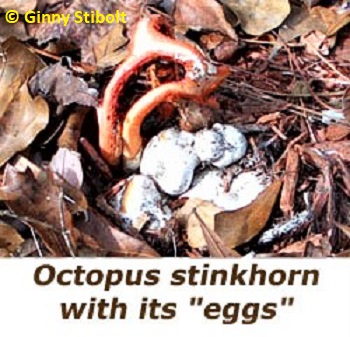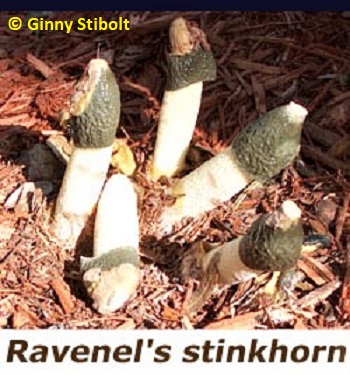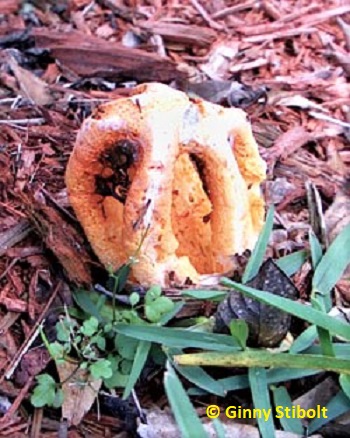Adventures of a Transplanted Gardener |
|
Pee-yew! Those smelly stinkhorn fungi
| |
|
|
I love finding surprises in the garden, but not these obnoxious winter fungi. Two different species of stinkhorns have popped out of their egg-like cases in several areas. I know fungi are beneficial for good soil and all, but stinkhorns are NOT a welcome addition.
The odor of the octopus stinkhorn (Clathrus columnatus) with its weird orange fruiting body is so strong, you can smell it from 50 feet away. I gagged and my eyes watered as I removed about ten pounds(!) of them.
Fungi fundamentals
Before we continue our discussion, let’s cover some fungus fundamentals. When I took biology, there were two kingdoms of living things, the plants and the animals. Fungi were grouped with the plants, but now they have their own kingdom. (For more on the five kingdoms: Rice University)
Most soil fungi start as a spore, and grow a long, thread-like white or clear hollow tube called a hypha with or without dividing walls called septae. A mass or web of hyphae is called a mycelium. Hence the study of fungi is called mycology.
Fungi don’t ingest their food like animals do, and they don’t manufacture their own food the way plants do. Instead, fungi secrete digestive enzymes at each hypha location to break down the substrate and release nutrients.
Most fungi are saprophytes, feeding on dead or decaying material; but many fungi are parasitic, feeding on living organisms. Some are symbiotic--the fungi live in a mutually beneficial relationship with another organism. Lichens are an example: fungus provides structure and protection for an alga that produces sugar through photosynthesis. (Note: Recently, it was found that bacteria are also part of that symbiotic organism. Read my article, "Lichen: a three-way symbiotic organism.)
As part of their life cycle, fungi produce spores. The sexual phase is begun when hyphae from two different fungal organisms meet and fuse. The resulting fungal fruiting body could be a delicious mushroom, a beautiful turkey tail or an obnoxious stinkhorn. The fruiting body produces spores and it provides a way to identify a fungus without a microscope.
According to many authorities: “A single gram of soil (about 1/5 teaspoon) can contain over 100 million bacteria, 1 million actinomycetes and 100,000 fungi with hyphae if strung together would measure 5 metres in length…. The exact proportions of each of these organisms will depend on soil conditions such as available moisture, aeration, organic matter levels and the type of plants present. Chemical conditions such as acidity and alkalinity will greatly affect organism populations. Fungi like acidic soils, while actinomycetes are found in more alkaline conditions.”
Note: Actinomycetes gives good soil that wonderful earthy smell. It used to be considered a fungus because it is filamentous, but it has been demoted to a bacterium because it has no nucleus.
If you have a compost pile (and everyone should), you know how fast this combination of bacteria and fungi get to work. After the hurricanes, our neighbor had a sweet gum tree just over our property line taken down because it was leaning toward his house. The tree service shredded a large portion of the tree creating a huge pile of mulch. My husband and I carted the 50+ wheelbarrow loads of mulch to our gardens. We noticed steam arising from the pile within only two days. All those bacteria and fungi had already started working to break down the wood. Ah, the great decomposers—what would we ever do without them?
The stinkhorns
Stinkhorns are appropriately named, as they all have a foul-smelling slime covering some part of the fruiting body. The slime attracts flies and other insects that normally feed on or lay their eggs in carrion or feces. The spores either adhere to or are eaten by the insects and are dispersed far and wide by the duped insects. It’s ingenious really, but before you give the stinkhorns credit for originality, many flowering plants also produce a foul stench to attract flies for pollen dispersal.
 All stinkhorns arise
from an egg-like sack and are therefore related to puffballs and earthstars
because the spores are enclosed in a structure. See the picture of my
octopus stinkhorn with eggs that would have sprouted the next day. The
two stinkhorn families, phallaceae and clathraceae, are classified according
to the structure of the fruiting body and I’m lucky(?) enough to have
a representative from each family.
All stinkhorns arise
from an egg-like sack and are therefore related to puffballs and earthstars
because the spores are enclosed in a structure. See the picture of my
octopus stinkhorn with eggs that would have sprouted the next day. The
two stinkhorn families, phallaceae and clathraceae, are classified according
to the structure of the fruiting body and I’m lucky(?) enough to have
a representative from each family.
The octopus stinkhorn (Clathrus columnatus) with its branched fingers belongs to the Clathraceae family. The dark colored slime clings to the inside of the structure and smells like something died. I found a couple of these in various gardens where the previous owner had piled on the red bark mulch, but I found about ten pounds of them in the area where I had transferred some of that mulch. I could see the white threads of mycelium in the mulch as I moved it, but if I’d known that I was facilitating stinkhorns, I’d have disposed of the whole pile right then. That’s why this is an adventure, you just never know what will happen.
I triple bagged all those smelly octopi stinkhorns and their eggs and left them with the trash, but I still saw vultures circling overhead looking in vain for something dead. I found out while researching this article that there is a big market for the stinkhorn eggs in Asia, and some people claim that if you slice and fry the eggs, they’re quite edible. Given their putrid stench once they’re out of the egg, I’m not at all tempted.
 As you might have guessed
from the family name, phallaceae, this group has a familiar shape and
size. I’ve been finding these seven or eight-inch-tall Ravenel’s stinkhorns
(Phallus ravenelii) for the last few months, mostly right in
the front garden near our front door. Sometimes they grow in a group;
other times as single shoots. They sprout up from an egg-like sack overnight
with their brown slime smelling more like feces and less like carrion,
though not nearly as strong as the octopus stinkhorns. By the end of
the day, they look like they could use a dose of Viagra.
As you might have guessed
from the family name, phallaceae, this group has a familiar shape and
size. I’ve been finding these seven or eight-inch-tall Ravenel’s stinkhorns
(Phallus ravenelii) for the last few months, mostly right in
the front garden near our front door. Sometimes they grow in a group;
other times as single shoots. They sprout up from an egg-like sack overnight
with their brown slime smelling more like feces and less like carrion,
though not nearly as strong as the octopus stinkhorns. By the end of
the day, they look like they could use a dose of Viagra.
Similarly shaped stinkhorns that grow in Europe have caused a ruckus over the centuries. Pliny The Elder wrote about them in the first century and people in the Victorian era were incensed. Charles Darwin’s grandniece wrote about her Aunt Etty, Darwin’s eldest daughter:
"'In our native woods there grows a kind of toadstool, called in the vernacular The Stinkhorn, though in Latin it bears a grosser name. This name is justified, for the fungus can be hunted by the scent alone; and this was Aunt Etty's greatest invention: armed with a basket and a pointed stick, and wearing a special hunting cloak and gloves, she would sniff her way round the wood, pausing here and there, her nostrils twitching, when she caught whiff of her prey; then at last, with a deadly pounce, she would fall upon her victim, and then poke his putrid carcass into her basket....The catch was brought back and burnt in deepest secrecy on the drawing-room fire, with all the doors locked, because of the morals of the maids! ' [Gwen Raverat, a niece of Charles Darwin]'."
In West Virginia near the Pocatalico River (shortened to Poca)
there’s another story:
The PocaPostannounces the release of a new stamp recognizing the official
mushroom of the Poca River.
“The mushroom is commonly known as a 'stinkhorn' (genus Phallus, var. fridlii). The fungus is very closely related to the more common Phallus ravenelii which is often found in sawdust piles and old lumber yards east of the Mississippi River.
“The Poca variant gets its name from an incident that occurred in 1887 in a lumbering area north of the Poca. A lumberjack, Fulton Fridley, passed away on a cold January day as he was working a buck saw. His co-workers, unable to inter him because of frozen ground, buried him in a sawdust pile until the spring thaw.
“When they returned in the spring to bury the body, they found a P. fridlii mushroom growing on the sawdust. Thinking that they were seeing a portion of Mr. Fridley pushing up through the sawdust, they fled as quickly as possible fearing that Fridley had spectral powers. When cooler heads prevailed, the truth was discovered. Following the incident this variety of the mushroom became locally known as the Fridley Toadstool, and has been recorded in the annals of mycology as Phallus fridlii. According to the scientific literature, the fungus is edible, but not recommended.”
In case you see me peering in and around my mulched garden beds, I’m looking for rude and smelly surprises. And you can bet that I will NOT be buying the red-colored mulch from which the all my stinkhorns have sprouted.
For more information on Stinkhorns see: Kuo, M. (2004, November). Stinkhorns: Phallaceae and Clathraceae on the MushroomExpert.Com Web site
Ginny Stibolt is a life-long gardener, a botanist, a naturalist, and a garden writer. You may contact her or read more of her articles posted on her website: www.greengardeningmatters.com.
Copyright Ginny Stibolt


